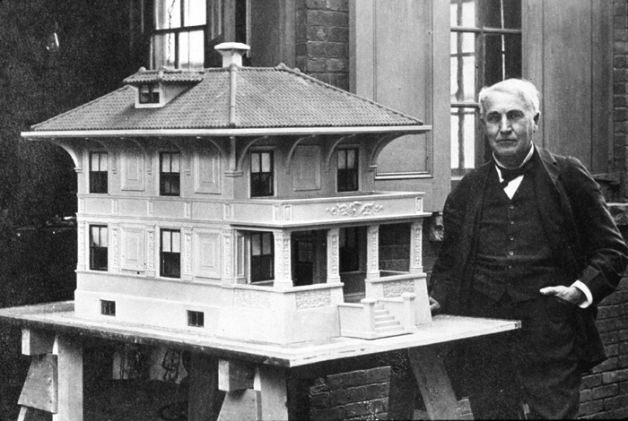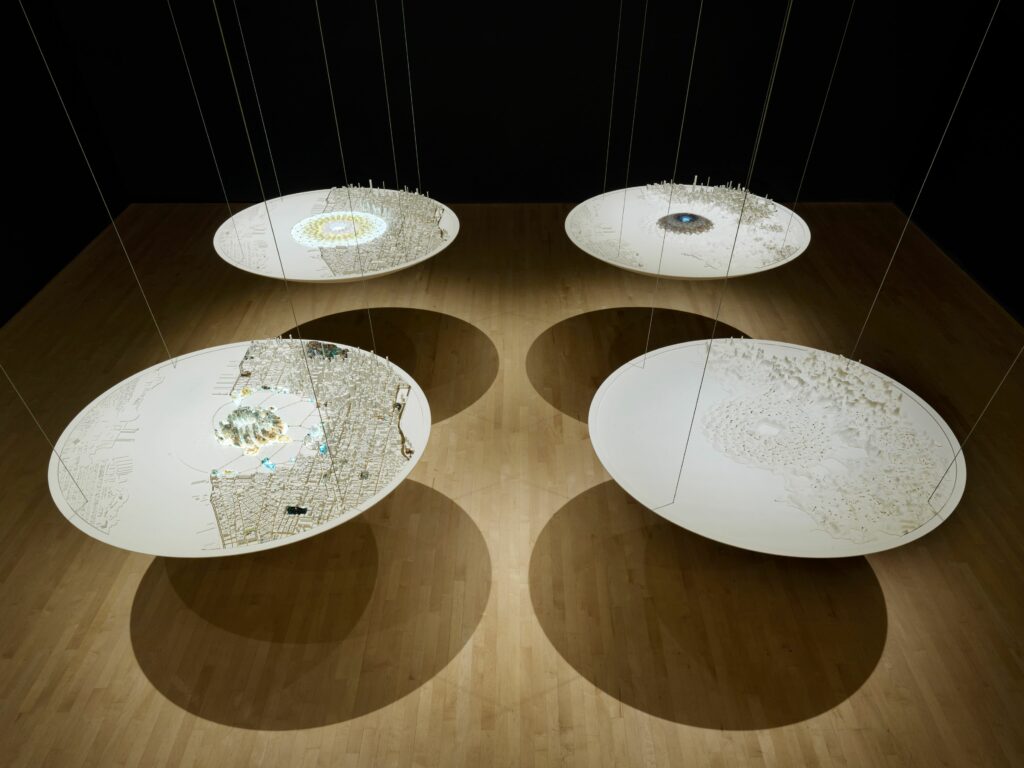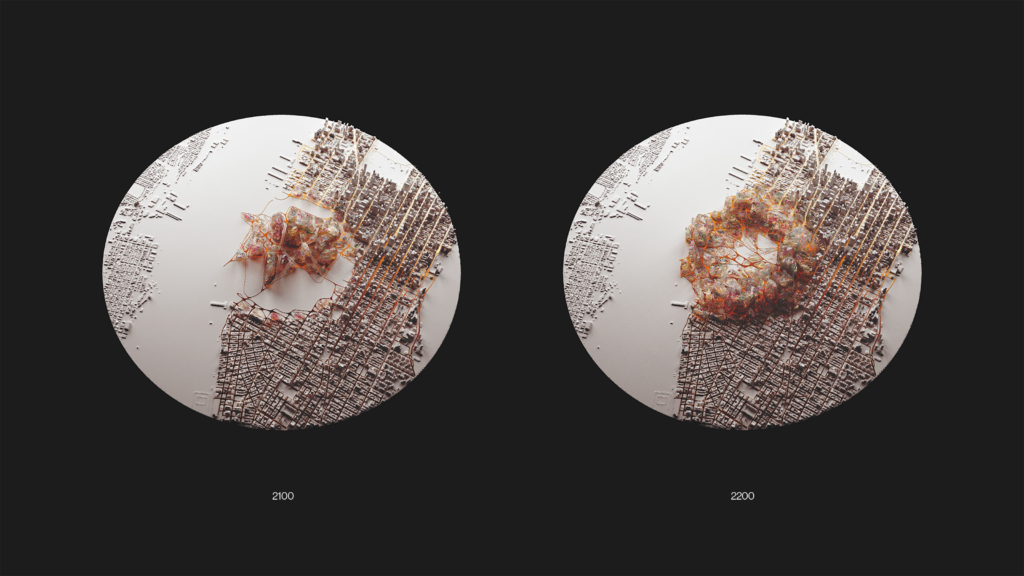Like Disaster
If you went to the Museum of Modern Art in San Francisco this spring you could see a big small thing, a model that imagines what Manhattan will look like in 400 years. Actually Man-Nahāta is not one model but four, which hang in a square. Starting at the bottom left and walking clockwise you see a version of the city every hundred years, beginning in 2100. Emergence, the first in the series, is a grid of streets and skyscrapers, except for where an organic glassy form appears in Central Park, black and yellow and blue lit from below, awful. In Growth (set in 2200) the form expands in concentric and overlapping spirograph shapes, an almost periwinkle blue at the edges, rippling amber toward the center, where it calcifies into hills. By Decay (2300) it flows back, leaving edges of buildings made soft, eroded into shapes like melted candles. In Rebirth (2400) the built environment is overgrown, peaks and valleys where a city used to be, made of white chalky photopolymers and fiberglass.
Man-Nahāta was commissioned by the director Francis Ford Coppola, who hired the architect Neri Oxman and the OXMAN group to create studies for Megalopolis, an epic set in a future New York City that starts production this year. Made for a movie that does not yet exist, the model has its own narrative, based in part on the projected mean global sea level and surface temperature rise in the Sixth Assessment Report of the Intergovernmental Panel on Climate Change. Most people walked around it the wrong way, or maybe not wrong but counterclockwise, changing the story. The glassy form recedes, buildings sharpen, streets reappear. You could circle the model again and again, speeding up or slowing down time, repeating the disaster or undoing it. Susan Stewart writes in On Longing that the miniature, “linked to nostalgic versions of childhood and history, presents a diminutive, and thereby manipulatable, version of experience, a version which is domesticated and protected from contamination. It marks the pure body, the organic body of the machine and its repetition of a death that is thereby not a death.”
***
Film has always tangled with architecture and invention. Brian R. Jacobson writes about this history in Studios Before the System. In 1888, Eadweard Muybridge took his pictures of horses in motion to the New Jersey laboratory of Thomas Edison. Soon after, Edison filed a patent for the kinetoscope, an early moving picture machine. William K. L. Dickson and William Heise made the first film for the Edison Manufacturing Company in 1892. Around this time Edison was bought out of General Electric and started the Edison Portland Cement Company. He made designs for concrete homes that could be built with a single pour, which Edison described as “the most wonderful advance in science and invention the world has ever known, or hoped for.” The houses would be affordable, fireproof, and made on site. There is a photograph of the inventor next to a two-story prototype with a covered porch and balcony, windows evenly spaced, and decorative molding. Edison wears a dark suit, his tie askew and his left hand in his front pocket. Man and his little house.

Thomas Edison. Courtesy of the National Parks Service.
Architects and filmmakers use models to picture the new, unseen, or impossible. In this way they tend toward the utopian. They share a capacity to make and unmake, not always successful. Only a few of the Edison concrete homes were ever made. There is a 1901 stop-motion nonfiction film called Demolishing and Building Up the Star Theatre, made by the American Mutoscope and Biograph Company, rival to Edison. In the film, the Star is not a model, but filmed from across the street it looks little, manipulable. Awnings shift in the wind below a marquee decorated with stars, an arch where the name of the theater is printed in capital letters. Time passes in traffic and shadows, and the Star disappears brick by brick, from the top down: the deconstruction of a real building, but never the repair promised in the title.
The research team for Man-Nahāta included Christoph Bader, Anran Li, Nitzan Zilberman, David Franck, Grey Wartinger, Khoa Vu, and Neri Oxman, who collaborated with Kennedy Fabrications and Boris Belacon. Materials at SFMOMA directed visitors to the OXMAN website, though the first time I visited the museum there was nothing online about Man-Nahāta. Now there are computer simulations, architectural renderings, and an exploded view of the physical models. Coppola plans to spend $100 million making Megalopolis, here summarized as “about an architect seeking to rebuild New York City as a utopia in the wake of disaster.” Adam Driver plays the architect. @oxmanofficial describes itself as “fusing design, technology, and biology to enable a future of complete synergy between Nature and humanity.” Among their first principles is “I. Nature as co-client: We call for a shift in how we perceive clientele and commercial viability, turning Nature into a co-client within the design practice.”
***
At SFMOMA two different kids asked the adults with them, “Is this all of San Francisco?” I watched a couple try to guess the city. The woman said it looked like New York. The man said, “It’s not Chicago,” which was funny to me. It was easy to miss the wall text—for some reason printed on what looked like tracing paper—which included the projected temperature and sea level rise for each subsequent model and said: “OXMAN, based in New York’s populous Manhattan borough, revisited the precolonial history of the local terrain, when it was known as Mannahatta (‘land of many hills’), identifying a period of rich biodiversity. In the four site-specific models on view here, OXMAN envisions an ecological evolution in which Manhattan’s urban grid and Mannahatta’s biotic garden achieve symbiosis.” The model shows climate change and a way out of it, or at least the recovery of the built environment by the natural world. But something makes it hard to read.
By making disaster small we can see it better, or maybe we just like it that way. In the nineteenth century you could buy transferware plates of the Merchants’ Exchange Building during the 1835 Great Fire or see a touring diorama of the Royal Tar, a Canadian circus steamer that exploded in 1836. Cynthia A. Kierner describes these objects (and others like them) in Inventing Disaster. On May 31, 1881, a dam on the Little Conemaugh River broke and flooded Johnstown, Pennsylvania, killing at least 2,209 people. The 1901 Pan-American Exposition in Buffalo included a mechanical reenactment of the event, which the Edison Company recorded on film. San Francisco Disaster was made by the American Mutoscope and Biograph Company in May 1906, under a month after the April 18 earthquake and fire that destroyed almost 80 percent of the city and killed over three thousand people. From an aerial view somewhere south of Market Street, you watch a model of San Francisco burn, three minutes of real flames with the Ferry Building at lower right and a few other landmarks—the Call Building and a painted backdrop of Russian Hill and Telegraph Hill. Nothing is exactly where it should be, a compressed geography. When I showed this film in a class on disasters the students seemed relieved when I said it was maybe kind of boring. Like watching the Yule log on television.
“The amusement park and the historical reconstruction often promise to bring history to life,” Stewart writes, and like these the miniature can bring events “to immediacy, and thereby erase their history, to lose us within their presentness.” A few months ago a friend sent me a picture of an animatronic model of the 1906 landslide at the Haverstraw Brick Factory, taken at the Haverstraw Brick Museum in Haverstraw, New York. Nineteen people died in the disaster. You could watch a video of the model, but the model itself was not working. They were waiting, my friend said, for the animatronic landslide model mechanic from Massachusetts, who was coming the next day.
***
There are two kinds of special effects, visual and practical. Visual effects involve the manipulation of film stock, or computer generated images. Practical effects include things like makeup, props, and explosions. Some kinds of disasters are easier to make than others, like wind and storms. Fire and floods are harder. Before backlots and movie ranches, California studios filmed at nearby locations like Griffith Park, and once burned down a ranger cabin. In mid-century Hollywood, mechanical sets and models were used to stage disasters. Some of these were made for movies about real events, which spend an hour on detailed reconstruction of the historical past, and then destroy it. Here comes the big one.
James Basevi and A. Arnold Gillespie designed a full-size set for the earthquake in San Francisco (1936) that rolled and split apart to precede a montage directed by John Hoffman. For In Old Chicago (1938), Fred Sersen, Ralph Hammeras, Louis J. Witte, H. Bruce Humberstone, and Daniel B. Clark used matte screens and burning eight-foot miniatures to recreate the 1871 Great Fire. “The transcendence presented by the miniature is a spatial transcendence, a transcendence which erases the productive possibilities of understanding through time,” Stewart writes. “Its locus is thereby the nostalgic. The miniature here erases not only labor but causality and effect. Understanding is sacrificed to being in context. Hence the miniature is often a material allusion to a text which is no longer available to us, or which, because of its fictiveness, never was available to us except through a second-order fictive world.”
Theodore and Howard Lydecker made many of the best practical effects in mid-century Hollywood. Their father worked for the actor Douglas Fairbanks and designed miniature golf courses. The brothers joined Republic Pictures in 1938 and created everything from title cards to props. They were skilled at pyrotechnics and demolition but their main work was building and filming miniatures, with Theodore as designer and Howard behind the camera. Not every model was wrecked. Some gave a sense of place, a wider view: towns and cities and the scale railroad they built for the Joan Crawford western noir Johnny Guitar, shot in natural light. They hardly ever used painted backdrops, instead filming from well-chosen angles and in slow motion, which when sped up to normal rate gave footage the right sense of mass and scale, complete with papier-mâché bat men and balsam airplanes that exploded in the sky. (Stewart writes that the “reduction in scale which the miniature presents skews the time and space relations of the everyday lifeworld, and as an object consumed, the miniature finds its ‘use value’ transformed into the infinite time of reverie.”) An outdoor model based on photographs of the San Gabriel Dam was decorated with tiny trees and held up to thirty gallons of water. In The Phantom Empire (1935), Gene Autry is captured by aliens and taken to an underground city called Murania, a model kingdom later destroyed.
Flame of Barbary Coast (1945) is set before the 1906 earthquake and fire in San Francisco, and like in San Francisco and In Old Chicago you wait around for the disaster. John Wayne plays a cowboy turned casino owner whose first line is “Big, isn’t it?” He is looking at the Pacific Ocean. But a disaster movie is always a question of scale. The earthquake sequence cuts together collapsing set walls, rolling pavement, cracking brick, a broken water main, a falling telegraph pole, and fire. Some of the footage has an odd and almost tilted focus: small made to look big. The Lydecker brothers built a six-foot-tall San Francisco. In one production photograph, Howard, Theodore, and two crew members work on a row of Victorian buildings. Through the windows you can see interior walls already collapsed. A man in a white shirt extends to reach the top floor, one last touch before the model is burned down. After the disaster a newspaper reads:
Quake damage less than expected
Destruction confined to limited area
Fire greatest hazard
***
A sign at the beginning of the OXMAN show:
The artworks in this show are delicate.
Please do not touch or interact with them.
Man-Nahāta was suspended about three feet off the floor, for me about waist height. To look at it I had to bend. Crouched, forward, curious, I saw a layer of dust had settled on the city. I felt self-conscious, aware of how small and fragile the model was. It was easy to imagine Manhattan ruined by me. Maybe this is an accident, the way the model recreates the disaster it describes, or at least our responsibility for it—the anthropocene in miniature.
The second time I went to the museum, I watched a guard warn visitors away. It happened at least four times. There was a pair of women, and a man on his own who moved to another part of the gallery after being told to watch his feet. A teenage boy and his mom, who walked right to the center of Man-Nahāta. Another woman did the same thing. I smiled at the guard, who came over to talk to me. She told me to take a picture, now that the area was clear of people, and because it seemed like I liked the model, let me know that the show was closing soon. I thanked her and went back to a nearby bench. I sat there a long time. I think what I really liked was watching people cross the line.
Rachel Heise Bolten is a writer based in California.
Copyright
© The Paris Review


